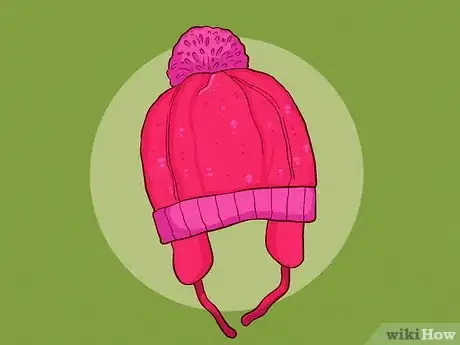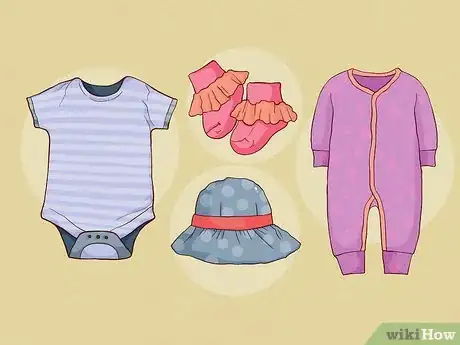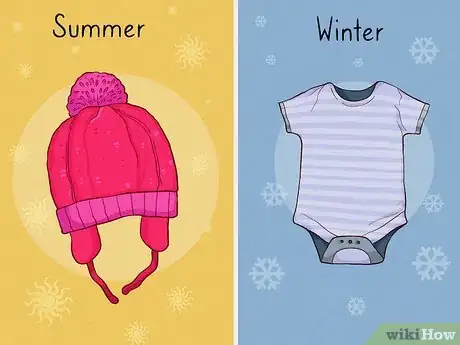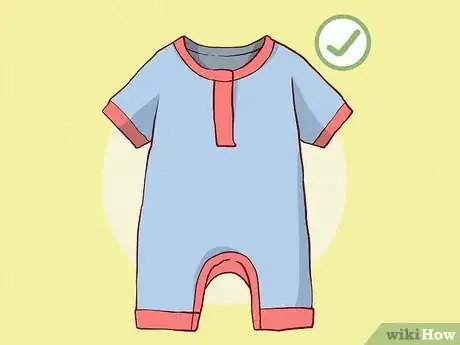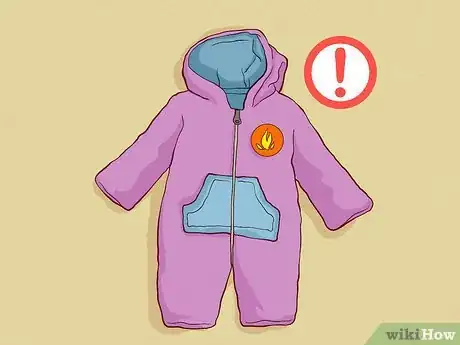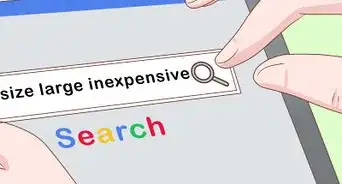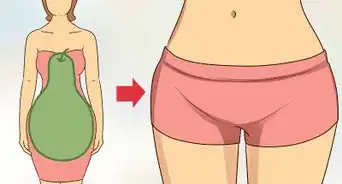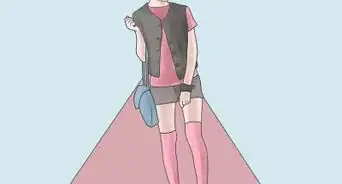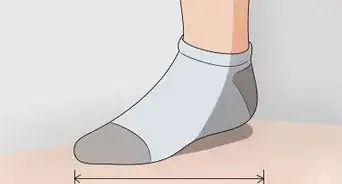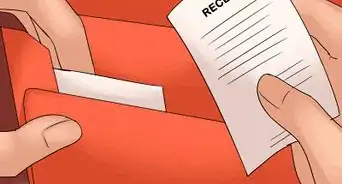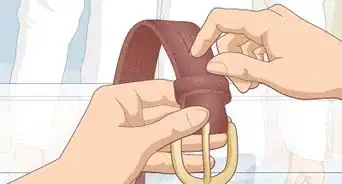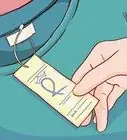This article was co-authored by Julie Wright, MFT. Julie Wright is a Marriage and Family Therapist and the co-founder of The Happy Sleeper, which offers sleep consulting and online baby sleep classes. Julie is a licensed psychotherapist specializing in babies, children, and their parents, and the co-author of two best selling parenting books (The Happy Sleeper and Now Say This) published by Penguin Random House. She created the popular Wright Mommy, Daddy and Me program in Los Angeles, California, which provides support and learning for new parents. Julie's work has been mentioned in The New York Times, The Washington Post, and NPR. Julie received her training at the Cedars Sinai Early Childhood Center.
There are 8 references cited in this article, which can be found at the bottom of the page.
This article has been viewed 25,896 times.
Buying baby clothes can be an overwhelming and frustrating task. Not only do you need to pick clothes that will fit the baby, but you need to consider what is cute on the baby. In addition, you'll need to do a lot of planning since babies grow fast and outgrow clothes almost as quickly as they fit correctly. Because of this, buying clothes for a baby is perhaps one of the most challenging shopping experiences you can engage in. Fortunately, though, with a little information and some time, you'll be able to buy baby clothes in an efficient and effective manner.
Steps
Selecting Clothes
-
1Choose clothing that will be easy to change. You'll discover very quickly that you prefer baby clothes that are easy to put on and remove from the baby. If clothes are hard to change, it'll frustrate you, take more time, and maybe upset your little friend.
- Try to focus on elastic clothes.
- Avoid clothes with buttons. Instead, opt for Velcro.
- Focus on clothes with removable bottoms.
- Pick baby clothing that allows for easy diaper changes. Dressing baby in layers and two-pieces, rather than one-piece outfits without easy diaper access, are also preferable options.[1]
-
2Focus on soft fabrics. The softness of fabrics is very important when buying baby clothes. Ultimately, just as you wouldn't want to wear uncomfortable clothes, babies don't want to either. Make sure to focus on clothes made out of fabrics you'd want to wear yourself.
- Check for tagless options.
- Avoid wool.
- Focus on high thread count cotton.
- Consider synthetics like polyester.[2]
Advertisement -
3Buy clothes appropriate for the season. An important factor to consider when buying baby clothes is making sure they are appropriate for the season. Having baby clothes appropriate for the season will make sure your baby is properly suited for the weather and also looks stylish.
- Warm clothes are absolutely necessary in the winter time. Make sure to consider warm onesies, socks, booties, and head coverings.
- Make sure the baby is not too warm in the fall, spring, or summer. Don't weigh them down with winter gear just because it looks cute.[3]
-
4Focus on necessities for the first six months. You should only focus on necessary items for the first six months of a baby's life. The ultimate reason is that babies grow really fast and will outgrow clothing items shortly after they can wear them. Consider these items:
- Purchase onesies and body suits. These can have snaps down the front or side, and between the legs. They can also be long or short sleeve, depending on the weather. You can also layer onesies under other clothing during cold weather.
- Invest in comfortable pajamas your baby can sleep in each night.[4]
- Choose pairs of comfortable pants that can be removed easily for diaper changes.
- Select baby hats and a quality sun hat to keep the heat in. A baby's head should be covered the first few months to protect from the cold and the sun.
- Stock up on socks and booties. Baby shoes are not actually necessary until the baby starts to walk.
- Gather lots of bibs.[5]
-
5Opt for clothing that launders easily. Buying clothes that launder easily is very important since the baby may spit up or otherwise mess their clothing frequently. Because of this, you might go through a couple of sets of clothing a day and quickly accumulate a lot of clothing to launder. As a result, you'll want to focus on clothes that launder easily – this will save you a lot of time.
- Avoid knits, as you'll need to hang dry them. In addition, they might pill or degrade quickly if not taken care of.
- Recognize that cotton shrinks when exposed to heat.
- Wash wool with cold water and at all costs avoid the dryer. Because of this, wool baby clothes might be a bad choice.
-
6Purchase baby clothing that is at least one size larger than the baby needs at the time. This is not only because babies grow fast, but so that you can use the outfit longer. As a result, think carefully about purchasing clothes big enough whenever you buy new clothes.
- While at the outset you may not want your baby's clothes to be too big, you'll thank yourself when you see a shirt or a pair of jammies lasting double as long as they would have otherwise.
- You can use a size forecaster like http://www.sizecast.com/ to predict your baby's future size.
- If you decide to purchase an outfit for when the baby is six months or older, make sure that you take into account what the season will be when the outfit will eventually fit.[6]
Factoring in Cost
-
1Watch for sales. A great way to save money when buying baby clothes is to watch for when department stores and other retailers have sales. Sales will provide a great opportunity to stretch your dollar and buy baby clothes.
- Subscribe to popular couponing websites, like Groupon, so you can get alerts when coupons or sales are available at your favorite retailer.
- If you have a favorite store for your baby's clothes, see if you can become a club member there so that you'll get e-alerts about sales.
- Check your local Sunday paper for sales in your area.
- Browse the websites of large online retailers regularly.[7]
-
2Buy or acquire used clothes. A great way to save money on baby clothes is to buy used. Buying used will aid in the process by making sure you have a lot more money to spend. Not only will you be able to buy more of a diversity of clothes, but you'll make a limited amount of money go a lot farther in terms of the baby's age and clothing needs.
- Visit thrift stores.
- Shop and sell on online consignment shops.
- Look to second-hand specialty baby stores.
- Ask friends and family if they have old baby clothes they don't need anymore.[8]
-
3Buy out-of-season clothes. Save money by purchasing baby clothes at the end of the season for the following year. While it might take a lot of planning, because you'll have to account for the age of the baby at a given time of the year, you'll wind up saving a lot of money.
- Carefully consider your baby's size and age at the time.
- As the summer season comes to an end, consider purchasing next year's summer clothing for the baby. Do the same at the end of winter. You can save a substantial amount of money when purchasing from end of season clearance items.
- Just like with buying in-season clothes, make sure that you buy large to provide extra space for unexpected growth.
-
4Buy small amounts. Whenever buying clothes for a baby, always buy small amounts. This is because babies grow fast. You didn't want to stock up on clothes only to have the baby outgrow them. Good planning and control will wind up saving you a lot of money.
- Buy clothes as you need them.
- Consider buying clothes every other weekend or even once a month. Plan for several weeks at a time, rather than for several months or a whole year.
- When buying larger sized clothes for the future, don't buy too much at one time either. If you see a great deal, buy a little bit, not a lot.[9]
-
5Choose unisex baby clothing that both genders can wear. Buying unisex baby clothes is another great way to save money. If you plan on having more children, unisex clothing will allow you to reuse the clothing. The clothes will also have more appeal on the resale market.
- Colors that are considered unisex include yellow, mint green, orange, cream and white.
- Don't feel obligated to stick to supposed “gender specific” colors. Clothe the baby in whatever you think is appropriate or in what the baby seems to prefer.
- Most all jammies and onesies can be unisex.[10]
Keeping Safety in Mind
-
1Be aware of the problems associated with fire retardant clothing. Fire retardant clothes have been popular for years as a safety measurement to reduce the risks of fire. However, in recent years, researchers have demonstrated the possibility that fire retardants might cause cancer or other health problems. As a result, make sure to carefully consider the pros and cons of fire retardant clothes.
- Risks of fire and fire retardant clothes can be mitigated by making sure your home is free from common fire hazards like open flames, people smoking inside, or faulty electrical wiring.[11]
-
2Stay away from clothes with beads or small pieces that can be removed. Clothes with small pieces may present a choking hazard to babies. This is because the child may be able to remove the bead or other small detachable piece and eat it.
- Cut off any bead, plastic, or any other small pieces that a baby may be able to remove from clothes and choke on.
- Avoid sequins. While sequins might seem cute on a baby, the baby might be able to remove them and wind up eating them.
-
3Avoid drawstrings. Drawstrings on the neck of baby hoodies or on the waistbands of pants can be a hazard to babies. Drawstrings present a strangulation hazard to babies. As a result, stay away from drawstrings.
- Focus on clothes with elastic instead of drawstrings.
- Remove drawstrings from any clothes you may have.
- Return any gifts people give you that may have drawstrings.[12]
Expert Q&A
-
QuestionWhat clothes should I buy for my baby to sleep in during warm, summer months?
 Julie Wright, MFTJulie Wright is a Marriage and Family Therapist and the co-founder of The Happy Sleeper, which offers sleep consulting and online baby sleep classes. Julie is a licensed psychotherapist specializing in babies, children, and their parents, and the co-author of two best selling parenting books (The Happy Sleeper and Now Say This) published by Penguin Random House. She created the popular Wright Mommy, Daddy and Me program in Los Angeles, California, which provides support and learning for new parents. Julie's work has been mentioned in The New York Times, The Washington Post, and NPR. Julie received her training at the Cedars Sinai Early Childhood Center.
Julie Wright, MFTJulie Wright is a Marriage and Family Therapist and the co-founder of The Happy Sleeper, which offers sleep consulting and online baby sleep classes. Julie is a licensed psychotherapist specializing in babies, children, and their parents, and the co-author of two best selling parenting books (The Happy Sleeper and Now Say This) published by Penguin Random House. She created the popular Wright Mommy, Daddy and Me program in Los Angeles, California, which provides support and learning for new parents. Julie's work has been mentioned in The New York Times, The Washington Post, and NPR. Julie received her training at the Cedars Sinai Early Childhood Center.
Parenting & Baby Sleep Specialist The first thing to do if it's very warm out is make sure that you don't overdress your baby. The infant body learns to regulate temperature very quickly. Invest in light clothing to keep your baby cool in hot weather, especially if you do not have an air conditioner.
The first thing to do if it's very warm out is make sure that you don't overdress your baby. The infant body learns to regulate temperature very quickly. Invest in light clothing to keep your baby cool in hot weather, especially if you do not have an air conditioner.
References
- ↑ http://www.mothercare.com/advice-buying-guides-and-services/buying-guides/clothing/baby-and-kids-clothing/buyersguide-ms-clothing-sub1.html
- ↑ http://www.babycenter.com/0_how-to-buy-baby-clothes_10370611.bc
- ↑ http://www.parents.com/baby/clothes/dressing-baby-for-winter/
- ↑ Julie Wright, MFT. Childcare Specialist. Expert Interview. 6 March 2020.
- ↑ http://www.webmd.com/parenting/baby/baby-gear-guide-9/buying-baby-clothes.
- ↑ http://www.babycenter.com/0_how-to-buy-baby-clothes_10370611.bc
- ↑ http://www.consumerreports.org/cro/baby-clothes/buying-guide.htm
- ↑ http://www.consumerreports.org/cro/baby-clothes/buying-guide.htm
- ↑ http://www.babycenter.com/0_how-to-buy-baby-clothes_10370611.bc


